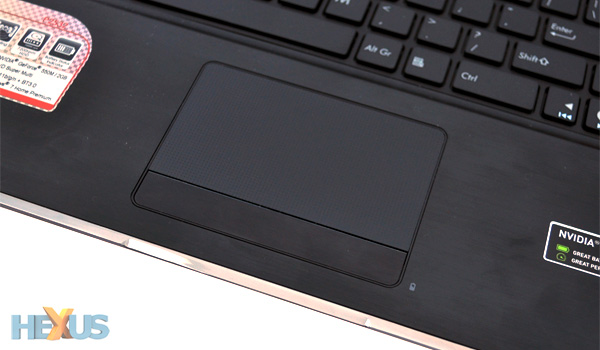User experience
Keyboard and trackpad
Historically speaking, Gigabyte doesn't tend to do things by halves. More of everything is usually the norm, and that line of thinking is visible in the P2532N laptop.
In addition to the high-power CPU, discrete GPU and full-HD display, there's a full-size keyboard with integrated numpad. Gigabyte's using every inch of available space, and while there's not a lot of room left either side of the keyboard, it doesn't feel particularly cramped.

The numpad keys have been thinned-out to ensure a neat fit, but the rest of the board is well spaced, and the island-style keys are of a good size. The top row of function keys double as shortcuts for common tasks such as volume control and wireless on/off, there are dedicated volume controls alongside the silver power button, and a strip of status LEDs along the right edge.
Once again, it's all very neat and tidy, but there are signs of flex beneath the keyboard tray. It isn't enough to disrupt the typing experience, but it reinforces the fact that this isn't the most rigid chassis you'll ever see. Nonetheless, the typing experience on the whole feels comfortable - the keys are lovely and quiet, and we felt right at home. If we were being ultra critical we'd add that the keys felt just a touch too shallow, and they aren't backlit, but after a short spell acclimatising, we were touch-typing as if we'd been using it for years.

It's mostly good news for the trackpad, too. Gigabyte has opted for a Synaptics LuxPad that's large and roomy, and the textured surface feels smooth and responsive in use. Multi-touch gestures work well and are aided by the size of the panel, and the large rocker below responds well to left and right clicks.
The keyboard and trackpad both have their positives, but they aren't quite perfect - particularly for users with large hands - as the trackpad isn't positioned in line with the space bar. As a result, we found the palm of our right hand accidentally brushing the trackpad while typing. The pad can be disabled via a function-key shortcut, but this arrangement won't suit everyone.
Display and sound
The 15.6in LED-backlit display is arguably the P2532N's strongest component. Offering a roomy 1,920x1,080 resolution, it puts the 15.6in form factor to good use and provides a good amount of on-screen real estate.

The resolution allows the user to spend more time being productive and less time scrolling, and it's great for multimedia use. Both vertical and horizontal viewing angles are surprisingly good - making it easy to share content with multiple viewers - and the screen is plenty bright with good colour reproduction.
It's a very enjoyable panel, but it's a shame Gigabyte hasn't put it to better use. The laptop's crying out for a Blu-ray drive to make the most of the full-HD display, and while the internal components are strong, they ultimately struggle to deliver high-quality, 1080p gaming (more on that later).
On the audio front, the integrated speakers are better than average. The integrated subwoofer struggles to provide depth, but the speakers are loud enough to entertain a few listeners, and they remain clear at full volume.
Software
Gigabyte's pile-it-all-in approach is usually a concern when it comes to software, but the out-the-box P2532N configuration is actually rather good.

There are too many desktop shortcuts and too many tray icons, but they're easily tidied up and there are few real nuisances.
By default, our sample shipped with a trial of Microsoft Office 2010, Bing Bar for Internet Explorer, Adobe Reader, Windows Live Essentials, Microsoft Security Essentials, and not a lot else. Using Microsoft's anti-virus solution is very much appreciated - it's far less intrusive than some of the alternatives - and Gigabyte's decision to keep it simple is a step in the right direction.
Though, only a step, as a few oddities remain. One example would be the "Gigabyte Smart Switch", which allows users to switch between 32-bit and 64-bit installs of the Windows 7 operating system. It works by using two different partitions (weighing in at 100GB each), and it might be advantageous to users who still need a 32-bit environment, but for the majority, it's a waste of hard-disk space.









